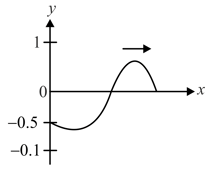Embibe Experts Solutions for Chapter: Wave Motion on a String, Exercise 2: Exercise-2
Embibe Experts Physics Solutions for Exercise - Embibe Experts Solutions for Chapter: Wave Motion on a String, Exercise 2: Exercise-2
Attempt the free practice questions on Chapter 20: Wave Motion on a String, Exercise 2: Exercise-2 with hints and solutions to strengthen your understanding. Beta Question Bank for Engineering: Physics solutions are prepared by Experienced Embibe Experts.
Questions from Embibe Experts Solutions for Chapter: Wave Motion on a String, Exercise 2: Exercise-2 with Hints & Solutions
A wave disturbance in a medium is described by , where and are in and is in :-
A string of length is stretched along the -axis and is rigidly clamped at its two ends. It undergoes transverse vibration. If is an integer, which of the following relations may represent the shape of the string at any time:-
A wave is propagating along -axis. The displacement of particles of the medium in -direction at is given by: , where ' ' is in meter. At , the same wave disturbance is given by . Then the wave propagation velocity is:-
The equation of a wave travelling along the positive-axis, as shown in figure at is given by:-

For a sine wave passing through a medium, let be the displacement of a particle, be its velocity and a be its acceleration:-
and are three particles of a medium which lie on the -axis. A sine wave of wavelength is travelling through the medium in the -direction. and always have the same speed, while and always have the same velocity. The minimum distance between:-
Sounds from two identical sources and reach a point . When the sounds reach directly, and in the same phase, the intensity at is . The power of is now reduced by and the phase difference between and is varied continuously. The maximum and minimum intensities recorded at are now and :-
Two audio speakers are kept some distance apart and are driven by the same amplifier system. A person is sitting at a place from one of the speakers and from the other. If the sound signal is continuously varied from to , then the frequencies for which there is a destructive interference at the place of the listener? Speed of sound in air .
